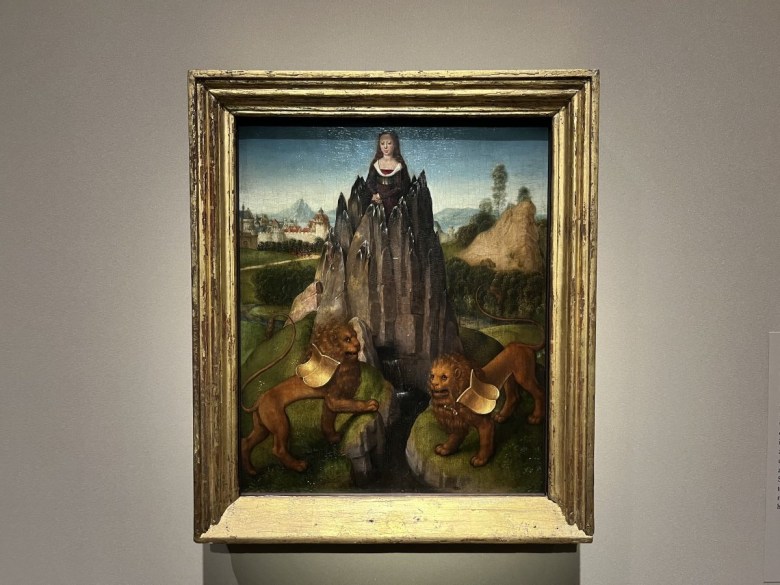It’s difficult to imagine a time when images of our faces were not only rare and expensive, but treated almost as sacred objects. But in 15th- and 16th-century Europe, portraits were often obscured behind curtains, affixed to folding diptychs, and slid behind mirrors where, hidden from everyday sight, they could be savored on special occasions. On view through July 7, the Metropolitan Museum of Art’s Hidden Faces: Covered Portraits of the Renaissance explores this under-recognized tradition, tracing the practice from its origins in Ancient Rome through its later iterations as portable mementos, like the lockets we still wear around our necks.
“We know that these images were intended to be conversation pieces, intended to be enigmatic,” the show’s curator Alison Manges Nogueira told Hyperallergic. The exhibition features more than 60 objects, many of them painted covers that served as introductions to the portraits they obscured. “As you see more of them, you start to realize how special they are.”
Hidden Faces opens with a double-sided portrait, a medium that features heavily in the show. Rogier van der Weyden’s circa 1460 artwork would have been rotated on a hook and chain, but here, it’s displayed on a pedestal where visitors can view it from all angles. The subject is Francesco d’Este, the favored son of an Italian duke. He holds a ring and hammer (either jousting prizes or symbols of his power), and the portrait’s reverse bears his family’s coat of arms. It’s a fitting introduction to the exhibition, which highlights these ancillary artworks’ function as tools to convey information about their patrons’ status and adherence to Renaissance virtues.
Accordingly, allegorical paintings of chastity and virility abound. The latter is sometimes expressed through the image of a scantily clad male form, a woodland creature common in Medieval European art and referred to as the “Wild Man.” He’s on full view — and near-naked — holding coats of arms in two 15th-century German portrait covers. Nogueira said these depictions symbolize the continuation of family lineage.
Unsurprisingly, women’s portrait covers were designed to project an entirely different set of virtues. In Dutch artist Hans Memling’s “Allegory of Chastity,” (1479–80), a female figure emerges from a mountain of crystalline rocks above a waterfall and two circling lions. The associated portrait’s whereabouts are unknown, but it may have portrayed a woman named Barbara, according to the catalog, as the namesake saint was covered in rock to protect her from her father.
While some allegories are easily interpreted, others are shrouded in mystery. Nogueira pointed to Lorenzo Lotto’s 1505 cover featuring a golden-haired woman reclining against a tree stump between two satyrs, with a hovering cherub pouring cool water onto her chest.
“It seems as though the image is depicting the triumph of virtue over vice, but it’s not entirely clear,” Nogueira said. “What tradition does the female figure come from? Does she come from love poetry from the 14th century? Does she allude to ancient literary traditions?”
Elsewhere in the show, other biographical hints verge on the petty. The verso of a mid-15th-century portrait of Guillaume Fillastre, a bishop and counselor to the Court of Burgundy, features a painting of thorny holly leaves and a Latin slogan translating to “I hate what bites,” a jab at the subject’s intellectual critics. In another by 15th-century Italian artist Jacometto, a Venetian woman wears a yellow scarf, a legal requirement to denote her profession as a prostitute. A Latin acronym painted on the reverse translates to “The whore dedicated herself to wantonness, license, lewdness,” alongside lines that likely allude to an Assyrian text meaning, “Though knowing full well that thou art but mortal, indulge thy desire, find joy in thy feasts. Dead, thou shalt have no delight.”




Hidden Faces marks the first time this type of Renaissance painting has been the subject of a museum exhibition. Personalized imagery such as coats of arms would have lost significance for subsequent owners, and some covers were treated only as protective shields, subjecting them to deterioration. Many covers are missing altogether. Still, scholars know the practice was widespread. Historical inventories cite covers’ existence, and in at least one case detailed in the show’s catalog, make special note of their absence.
As the centuries passed, hidden portraits morphed into portable mementos, sometimes distributed as wedding gifts. Nogueira noted that the concept of obscuring hanging artworks did not completely vanish, either: Gustave Courbet’s scandalous “The Origin of the World” (1866), for example, was first exhibited behind a curtain. The curator called the show’s Renaissance material “a sliver in a much larger tradition.”
One cover in particular speaks to the tradition of hidden portraiture — and to our current-day obsession with snapping photos of ourselves — with astounding clarity. Florentine artist Ridolfo Ghirlandaio’s “Cover with a Mask” (c. 1510), which once slid over the painting of the daughter of a famous Florentine merchant that is now hung next to it, bears the Latin inscription, “To each their own mask.”
“It speaks to the idea that everyone has a mask — everyone’s wearing a mask — or the theater of life, the kind of philosophical notion of it. But there’s also the idea that portraiture is a kind of artifice,” Nogueira said. “Even more interesting in the context of the exhibition is that the cover is playful and self-referential — it’s speaking to the role of all portrait covers as well.”






